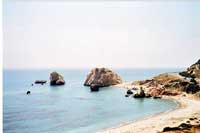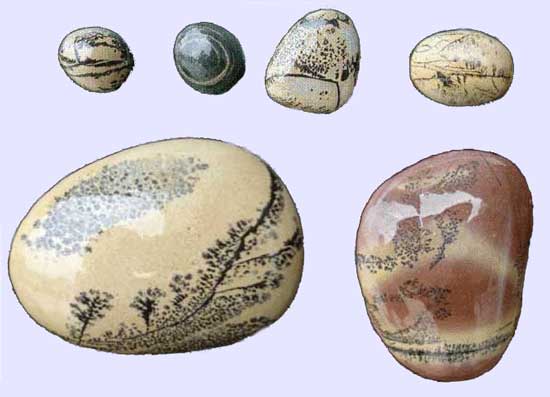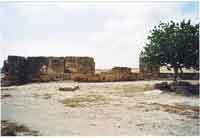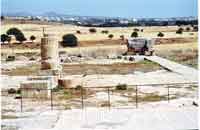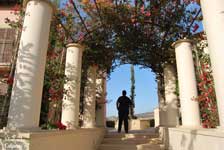.
Kouklia (Κούκλια ) is a village of the district of Pafos and lies at a distance of about 16 kilometres from the city of Pafos, Cyprus. It is built at an average altitude of 85 meters in the coastal plain of Pafos, north of the central highway of Limassol - Pafos, where -according to mythology -the goddess of Beauty and Love, Aphrodite, emerged. Kouklia receives an average annual rainfall of about 420 millimetres; grapevines (wine-making and table grape varieties), bananas, all sorts of citrus fruits, avocados, apricot, kiwis, olives, locust beans, legumes, peanuts, and a large variety of vegetables are cultivated upon its fertile land. The forest "Randi" in the south-east as well as part of the forest "Oriti" in the north-east are within its administrative boundaries. Stockbreeding is well developed in the community.
The very good geographic position of the village as well as the profitable agricultural and farming operations are factors that have aided the remarkable population growth. The inhabitants of Kouklia numbered 404 in 1881, increasing to 520 in 1921. In 1946 the inhabitants run into 791 (437 Greek Cypriots and 354 Turkish Cypriots) and in 1973 to 1110 (613 Greek-Cypriots, 494 Turkish-Cypriots, and 3 of other nationalities). After the Turkish invasion of 1974, the Turkish-Cypriot inhabitants of the village were coerced by their leadership to abandon the village and transfer to the occupied regions, along with all the other Turkish-Cypriots from the non-occupied areas. In 1976 the inhabitants of Kouklia were 732, which decreased to 681 in 1982. In the census of 2001 the inhabitants were 669.
The village is built in the venue were "Palaipafos" (Old Pafos) -the seat of the kingdom of Pafos -stood, which was one of the most important ancient kingdoms of Cyprus. The entire area of the community, including also the place where -today -the houses of the village are built, is an important archaeological region. Excavations have been conducted at times, bringing to surface the famous temple of "Aphrodite of Pafos" (Pafia Aphrodite), the remains of the fortification of Palaipafos, and various other movable findings that are found in the archaeological Museum situated in the village, housed in the medieval villa south of the village.
The village was in existence during the Byzantine years and must have been a property of the Byzantine officer "Kouvikoularios". The word "kouvouklion" meant sepulchral chamber but also meant the dormitory of the Byzantine emperors. The bodyguards of the Byzantine Emperors that guarded the imperial dormitory were named "kouvikoularioi" and often were granted pieces of land as a reward for their services. Such a "kouvikoularios" most probably became the master/owner of the village and so it was named Kou(vou)klia. Therefore, if Kouklia was not the property of a "kouvikoularios" then it must have been a place with country houses for Byzantine officials.
The village was still named "Kouvouklia" until the Frank domination era, instead of the abbreviated Kouklia. De Masse Latri reports that during the Frank domination era the village was a large royal estate in which sugarcane was cultivated. The large medieval villa of Kouklia proves that the village was an important feud.
During the era of Turkish domination, Kouklia were confiscated by the new conqueror and became a manor.
Today, Kouklia is a thriving community. Palm trees are planted in the main-street entrance of the village adding a special beauty. The streets of the village -clean and well looked after -bring the visitor to the central plaza where the church of the Apostle and Evangelist Luke stands. The inhabitants of the village are distinguished for their piety and respect for the sacred and the holly. Around the village there are either chapels or ruins of chapels that testify for the piety of the inhabitants.
There is a regional Elementary School in the village, which both the pupils of Kouklia as well as the ones from the neighbouring village Nikokleia attend. Also, a police station, a health centre, and a state-owned nursery (greenhouse) have their headquarters there. In the village plaza there are several coffee-houses and taverns that offer luxuriant food and entertainment.
The rapid tourist and structural development, the archaeological findings of the area, the "Petra tou Romiou" venue, the legend of Aphrodite, the unsparing natural beauty of the region, and the unique combination of mountains with the deep blue sea give the village of Kouklia a uniqueness that cannot be found anywhere else.
Petridis Christakis is the current Mayor of Kouklia.
Palaipaphos
The ancient said that Paphos was the navel of the earth as Delphi , the holy altar of Venus of Palaipaphos considered important like the holy altar of Apollon at Delphi. From 1200 BC Palaipaphos was a big religious center that became with time a place of adoration for crowds of faithful people , not only from all the places of Cyprus, but also from other countries of the Mediterranean.
The residents of Paphos and particularly those at Kouklia worshipped a goddess of fertility who protected life. They depicted her as a woman with obvious the characteristics of maternity. They manufactured from stone or clay, figurines of this goddess, certain bigger as objects of adoration and other smaller, that the women wore on their neck as amulets and other that they placed in the graves in order to protect the dead people. Thus it appears that the adoration of a goddess of fertility was presented first in the region of Paphos. The fable that says that Venus was given birth at its coasts perhaps is reported in the adoration of the goddess, which began to be worshipped here.
The adoration of this goddess becomes resplendent especially from the 12th century BC. It appears that already before the arrival of Achaeans, Palaipaphos was a rich city with one rich holy altar of the goddess. The king Kinyras of Paphos, as tradition says, was very rich and he was at the same time priest of Venus. But exists also one other tradition that says that Agapinoras, the king of Tegea of Arcadia, came to Paphos after the Trojan War and founded both the city and the holy altar of Venus. It appears that the Greeks were impressed by the greatness of the goddess of Paphos and they built a great holy altar, from which they are saved some architectural residues.
They worshipped her at its holy altar. It was never built a temple for her, but the holy altar was out door, encircled by walls, closed with bright doors, as Homer says . The view was not worshipped in the form of statue, but in the form of conical stone. The ancient report it as something strange " a white pyramid which the material is not known ». Without fail this symbolic stone existed in this place from the ancient years. The adoration of the standing stones is acquaintance in the eastern religions. Perhaps the standing rocks in the locality "Petra tou Romiou'" is what created the fable that Venus was given birth there.
It is this mysterious conical stone that was found near the holy altar and it is exposed in a room of the museum of Kouklia, with the difference that it is black while the ancient described it as white. Perhaps it was white and preened. It remained in the holy altar until the Roman season, placed in the intermediate part of a tripartite open building. In the space there was found the altar of the goddess, being famous already in the season of Homer as an incensed altar. It is said that, as by marvel the altar was never rained by the rain.
They existed also votive pillars, with symbols as the horns of a bull, and columns in form of a tree of life. There would exist also various buildings for the needs of the holy altar, where they perhaps lived, the priest of the goddess with the other people.
It is likely that existed a holy garden from which it has taken its name the village of Geroskipou. We should imagine perhaps a part of the holy altar as a garden with trees and bushes, dedicated in Venus, where they flew birds as the pigeons that were her beloved birds. Representations on vessels show us people between bushes, flowers and birds.
The goddess was worshipped as follows: a priest directed the ceremonies. As first priest is reported the fabulous Kinyras. His descendants continued being priests and were buried in holy altar of the goddess. We know also that the kings of Paphos, were simultaneously priests.
Perhaps these priests took place the "holy marriage", as it became from the Eastern religions to honor Astartis. That is to say one day the priest took place a marriage with the female priest so that it ensures for the coming time fertility of the earth and people.
It would also exist a priest of the goddess that lived perhaps in the holy altar. We can shape an idea from her appearance, from findings of the archaic season, that present a woman, rich embellished. It is the goddess that is represented from her priest.
The adoration of Venus was particularly brilliant and famous in the archaic season. Religious ceremonies are painted with a lot of details on old findings such as vases or bronzed vessels.
For the offers to Venus we have information from ancient writers. It appears that the offers from "Myra", tobacco or balm, were accepted. The faithful people brought also pies from flour and oil and produced libations from honey. They offered branches from trees, liked by the goddess, like "myrsini" and flowers, windflowers and roses, because they came out from the blood of Adonis and the teardrops of Venus.
With regard to the sacrifices of animals, the information does not agree. Certain say that the altar of the goddess was not wetted with blood. Certain supported that was never a scarification of pig to Venus, because she disgusted pigs, after the death of Adonis caused by a wild pig.
Others insisted that they sacrificed pigs to Venus. Faithful people dedicated things that presented worshippers or the goddess herself, either in the form of a decent woman richly dressed, or in the form of naked [[Astarte]. Others dedicated columns with signs, statues, precious gifts, gold. We know that holy altar of Venus was very rich. The Romans took many from the treasures in Rome.
The Ptolemaioi and the Roman, in order to give particular glamour to the holy altar, they tried they to import the adoration of emperors and other gods. The currencies of the season show the holy altar with the conical stone still in its place.
Every year, men and women from all over Cyprus, organize events, musical, theatrical, poetic and athletic, from the harbor of New Paphos to Palaipaphos. The goddess was worshipped for a lot of centuries at Palaipaphos, because the persons knew that she had enormous force and that she gave life and charms, but that it could be also malicious if they did not respect her.
The adoration of the goddess lost its glamour with the rise of Christianity. From the 2nd century AD they began to abandon the altars of the goddess. The big earthquakes of the 4th century AD destroyed the holy altar. With the building material of the idolatrous buildings, they built great royal ones. It was the end of big adoration of the ancient world.
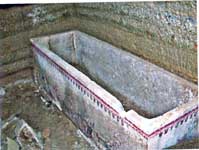

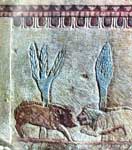
Palaipafos Sarcophagus with scenes from Homer's Iliad and Odyssey, discoverd 2006 in Kato Alonia near Kouklia. from, The sarcophagus of Palaipafos, Pavlos Flourentzos.Department of Antiquities, Cyprus 2007
Geography
Kouklia receives an average annual rainfall of about 420 millimetres; grapevines (wine-making and table grape varieties), bananas, all sorts of citrus fruits, avocados, apricot, kiwis, olives, locust beans, legumes, peanuts, and a large variety of vegetables are cultivated upon its fertile land. The forest "Randi" in the south-east as well as part of the forest "Oriti" in the north-east are within its administrative boundaries. Stockbreeding is well developed in the community. Palm trees are planted in the main-street entrance of the village adding a special beauty
Tourism
The unsparing natural beauty of the region, the "Petra tou Romiou" site , the archaeological discoveries of the area, the proximity to Aphrodite hills Resort and the elevated mountain views of the sea make kouklia a popular tourist destination.
Village
There is a regional Elementary School in the village, which both the pupils of Kouklia as well as the ones from the neighboring village Nikokleia attend. Also, a police station, a health centre, and a state-owned nursery (greenhouse) . In the village plaza there are several coffee-houses and taverns that offer luxuriant food and entertainment. central plaza where the church of the Apostle and Evangelist Luke stands. The inhabitants of the village are distinguished for their piety and respect for the sacred and the holly chapels or ruins of chapels that testify for the piety of the inhabitants. Petridis Christakis is the current Mayor of Kouklia.
Occupation
Most work in agriculture, some in tourism related activities , and some are employed in the Aphrodite Hills Resort complex.
Source
Links
| Ancient Greece
Science, Technology , Medicine , Warfare, , Biographies , Life , Cities/Places/Maps , Arts , Literature , Philosophy ,Olympics, Mythology , History , Images Medieval Greece / Byzantine Empire Science, Technology, Arts, , Warfare , Literature, Biographies, Icons, History Modern Greece Cities, Islands, Regions, Fauna/Flora ,Biographies , History , Warfare, Science/Technology, Literature, Music , Arts , Film/Actors , Sport , Fashion --- |
Retrieved from "http://en.wikipedia.org/"
All text is available under the terms of the GNU Free Documentation License

